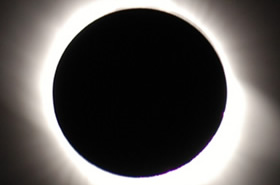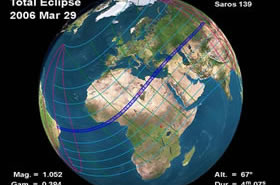Solar Eclipses
3.8 - Understand the appearance of the Sun during partial, total and annular solar eclipses, including the terms first, second, third and fourth umbral contactA solar eclipse only takes place during a new Moon when the Moon is on the side of the Earth nearest the Sun.
They take place because the Moon's disc totally covers the disc of the Sun. These are dramatic and beautiful events. The Sun is 400 times further away from us than the Moon but is 400 times larger and so they appear to be the same size.
Total solar eclipses can only last a maximum of 7 minutes 30 seconds because of the speed of the Moon orbiting Earth, the rotation of Earth and the focus of the Moon's shadow on Earth.
The eclipse will begin at sunrise at some part of the Earth and end at sunset at another point. Totality will only take place along a line on the Earth's surface where the shadow is focused called the 'line of totality'.
An observer outside of the area will see a partial solar eclipse.
A total solar eclipse can be best explained by looking at the various stages called contact points. We will examine this and presume the observer is viewing this on the line of totality.
Total Solar Eclipse
First Contact
The penumbra is projected at the observer's location. They see a partial eclipse. The limb of the Moon appears in front of the Sun. A small black arc appears cut out of the Sun's disc. Before first contact the sky will darken considerably and the temperature drops. Other things that may be noticeable include shadow bands shimmering on the ground before totality that resemble light reflected from water and animals behaving as if nighttime had arrived.
Second contact
The last rays of sunlight pass through craters on the disc of the Moon and produce a diamond ring effect known as Baily's beads. The umbra is now projected at the observer's location and totality begins. The sky becomes black. Stars and planets become visible. The Sun's corona is visible, and prominences may be seen.
Third contact
The Moon once again reveals the disc of the Sun; Baily's beads are again seen but the corona is no longer visible. The umbra moves along the line of totality.
Fourth contact
The Moon's disc leaves the disc of the Sun. The penumbra leaves the observer's location.
PARTIAL ECLIPSE
A partial solar eclipse can be seen when the Moon moves into the disc of the Sun but does not block it entirely as in a total solar eclipse. There are only two points of contact - when the moon starts and ends the transit of the Sun's disc.
ANNULAR ECLIPSE
This is not connected to any calendar function. 'Annular' is derived from the Latin 'annulus' meaning ring. The appearance is that of a ring, sometimes called 'a ring of fire'. When the Moon is further away from the Earth (apogee) the smaller moon does not cover the sun's disc completely. The focus of the Umbra is above the Earth's surface. The Moon will appear too small to cover the Sun. There is more direct light from the sun and so it is not possible to see the corona and other features in great detail.
HYBRID ECLIPSE
A hybrid eclipse is when a solar eclipse is annular when seen at some places on the line of totality and total in other places. They are caused because of the curvature of the Earth and the constant movement of Moon and Earth. At the peak of the eclipse it is sufficient to cause a total eclipse. At sunrise and sunset, the cone has further to travel and may be annular.
WARNING: Never view the Sun with a telescope or binoculars
Did you know?
- The eclipse shadow travels at over 1000 km per hour but much faster further north or south of the equator.
- The line of totality can be up to 270 km wide.
- Shadow bands occur before and after an eclipse and are caused by the light from the Sun curving due to the gravity of the moon and causing crescent shaped patterns on Earth.
- Solar eclipses only happen during a new Moon.
- At the poles you will only ever see partial solar eclipses.
Questions
- Why can the corona be seen at the time of a total solar eclipse?
- Draw a diagram with labels of a solar eclipse
Links
- Mr Eclipse The Experience of Totality
- Exploratorium What to see during an eclipse
- NASA Eclipse Find the next solar eclipse





-small.jpg)

 | © All Rights Reserved |
| © All Rights Reserved |